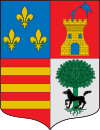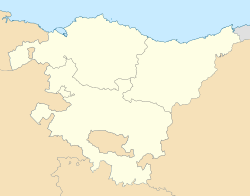Güeñes facts for kids
Quick facts for kids
Güeñes
|
|||
|---|---|---|---|

Church of St. Mary
|
|||
|
|||
| Country | Spain | ||
| Autonomous community | Basque Country | ||
| Province | Biscay | ||
| Comarca | Enkarterri | ||
| Area | |||
| • Total | 41.16 km2 (15.89 sq mi) | ||
| Elevation | 81 m (266 ft) | ||
| Population
(2018)
|
|||
| • Total | 6,681 | ||
| • Density | 162.32/km2 (420.40/sq mi) | ||
| Demonym(s) | Güeñés | ||
| Time zone | UTC+1 (CET) | ||
| • Summer (DST) | UTC+2 (CEST) | ||
| Postal code |
48840
|
||
Güeñes is a cool town (or municipality) in the Basque Country, Spain. It's located in an area called Enkarterri, in the province of Biscay. The Cadagua River flows through Güeñes. It's part of the beautiful Salcedo Valley, along with the nearby town of Zalla.
Güeñes shares borders with other towns like Galdames, Alonsotegi, Zalla, and Gordejuela. Some of its most important areas are Güeñes itself, Sodupe, La Quadra, Zaramillo, Sanchosolo, and San Pedro de Goicouría.
Contents
Exploring Güeñes: Towns and Population
Güeñes is made up of several smaller towns and areas. The main ones include Sodupe, La Quadra, Zaramillo, and the administrative center, Güeñes.
Population Centers in Güeñes
Here's how many people lived in some of the main areas in 2011:
- Central Güeñes: 2,213 people
- La Quadra (also known as Quadra-Lakabex): 420 people
- Sodupe: 5,117 people
- Zaramillo: 510 people
- Total Population: 8,258 people (according to INE 2011 data)
A Look Back: The History of Güeñes
Güeñes has a long and interesting history. Long ago, it was part of the Salcedo Valley, which included Güeñes and Zalla. This valley was started in the late 1100s by Count D. Rubio Diaz de Asturias. He ordered the building of the Tower of Salcedo of Aranguti, which later became a palace.
Early Lords and Families
The valley was later controlled by Maria de Salcedo, who married D. Galindo de Ayala. The Ayala and Salcedo families stayed together for many years. Other powerful people also had influence in the area, like Martin Sancho de Santa Marina.
In the early 1200s, Hurtado Sanz de Salcedo had two children with Martin Sanchez of Santa Marina. These children, Lope Sanchez and Sancho Ortiz Marroquin, inherited different parts of the valley. Sancho Ortiz Marroquin kept Zalla and Güeñes.
Later, Marroquin divided his lands among his children. This led to the creation of three important family lines: Montermoso Marroquin, La Jara, and Salcedo Salcedo Aranguren.
Times of Conflict and Peace
In the mid-1300s, different families in the Salcedo Valley started to have conflicts. These fights often began because of how Sancho Ortiz Marroquin had divided the land. Families like the Salazares and Muñatones fought against the Marroquines and Gordojanos.
This period was full of violence. Even the lords of Vizcaya and the kings of Castile found it hard to bring peace. However, by the late 1400s, things started to calm down. The economy improved, and more people moved to the area. The reasons for the fighting began to disappear.
Growth and Important Events
In the early 1500s, towns started to sort out their borders. In 1507, Güeñes and Gordejuela met to mark their shared limits. This helped prevent arguments about who controlled what land. During this time, making iron and farming more land became very important.
The building of the Santa Maria church also brought many jobs to Güeñes. This helped the town grow even more.
In 1624, leaders in Biscay decided to protect their ports from possible attacks by Dutch ships. They appointed captains in towns like Güeñes. In 1642, Mr. Jacinto Hurtado de Tavisón, a mayor of Güeñes, asked for Güeñes to become a full part of his manor.
In 1704, a "fogueramiento" (a fire to mark boundaries) took place in Güeñes. This was done to clearly define the different parts of the estate.
Later, in the late 1700s, Güeñes faced tough times with bad harvests, high taxes, wars, and diseases. To help the people, leaders removed some taxes and shared land so families could grow more food.
In 1800, Güeñes officially became part of the Lordship of Güeñes. During the War of 1808, French soldiers set up their base in Sodupe. This caused problems for the local people, as a lot of their farm produce was taken to feed the troops.
Famous People from Güeñes
Güeñes has been home to several notable individuals who achieved great things:
- Jacinto de Romarate: A respected Marine who defended Montevideo during the American War of Independence.
- Daniel Ruiz Bazán: A retired football player who played for Athletic Club in the 1970s and 1980s. He was born in Sodupe.
- Rosa Díez: A well-known politician. She served as a tourism minister in the Basque Government, was a Member of the European Parliament, and a founder of the Union Progreso y Democracia political party. She was born in Sodupe.
- Lorenzo de Arrieta Mascarua Sarachaga (1821-1891): A politician and member of parliament.
- José Miguel de Arrieta Mascarua Sarachaga (1817-1869): Also a politician and member of parliament.
Historical Buildings and Special Places
Güeñes has many interesting monuments and heritage sites. Here are some of the most important ones:
- Errecalde Farmhouse: This is a classic country house. It's one of the oldest buildings in the area and still has its original front. Today, the ground floor is used for animals, the first floor for living, and the top floor is a birdhouse.
- Palace of the Hurtado de Amézaga: This palace was started in the 1700s by don Baltasar Hurtado de Amezaga. Sadly, he passed away before it was finished, and the palace has been falling apart ever since. It's even on a list of world heritage sites in danger.
- St. Vincent Church: Finished in the 1700s, this church has three main parts and a simple, unadorned style. It's a great example of Baroque architecture.
- Sanchosolo Chapel: This small church, dedicated to San Martin de Iturriag, has a beautiful vaulted ceiling from the 1700s.
- Saratxaga Palace: This palace dates back to the 1000s and belonged to the Saratxaga family. It has a neo-classical look and a lovely garden.
- Cuadra Salcedo Palace: This palace stands where an older palace from the early 1500s once was. It has a neo-classical design and faces the old Royal Road.
- Arenatza Park: This is a large English-style park, covering 22,000 square meters. It has both local and non-local plants, a collection of cone-bearing trees, a pond, and a covered walkway.
- The Bridge Tower: This tower, also known as the Romarate tower, was built by D. Juan de Bolívar. It still has its battlements (the top part with gaps for defense) and four watchtowers at its corners.
- La Cuadra Tower: This is one of the best-preserved tower houses in Vizcaya. It was built in the late 1300s when there were many feudal conflicts.
- Sanchosolo Tower: We know about this tower since 1535. D. Lope I De Salcedo, the Lord of the Tower of Salcedo, gave it to his first son, D. Lope II De Salcedo.
- Sologuchi Tower: This is another example of a defensive tower. It was built in a smart location next to the Royal Road and belonged to the Lords of Salcedo.
- Villa Urrutia: This is a grand mansion built in a French style in the early 1900s by Leandro Urrutia. It was later given to the Garay Llaguno family in 1974.
- St. Michael Lacabe Church: This church was built in 1520. Its Renaissance dome was rebuilt in the 1700s.
- St. Maria Church: The impressive St. Maria Church was built in the 1500s. It combines elements of both Gothic and Renaissance architectural styles.
See also
 In Spanish: Güeñes para niños
In Spanish: Güeñes para niños




